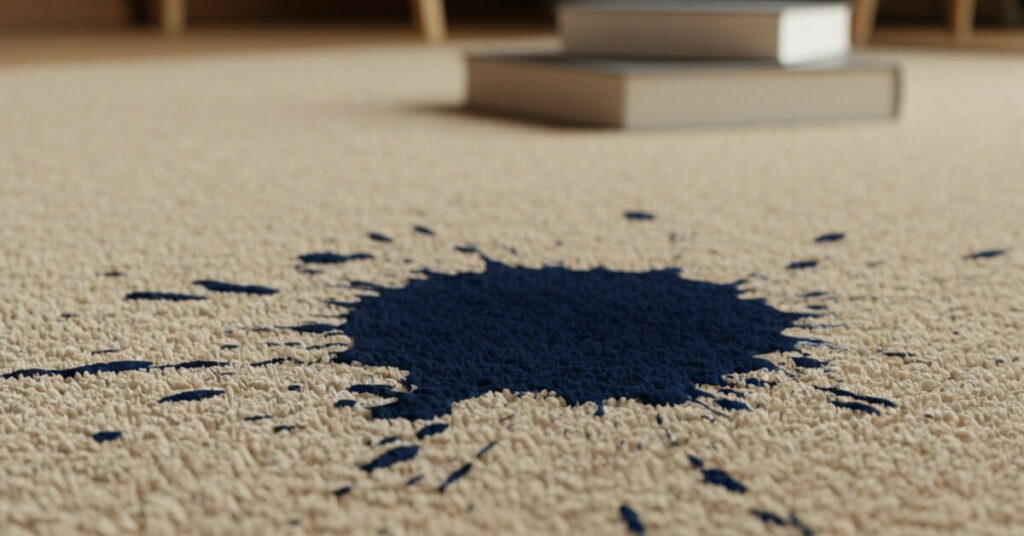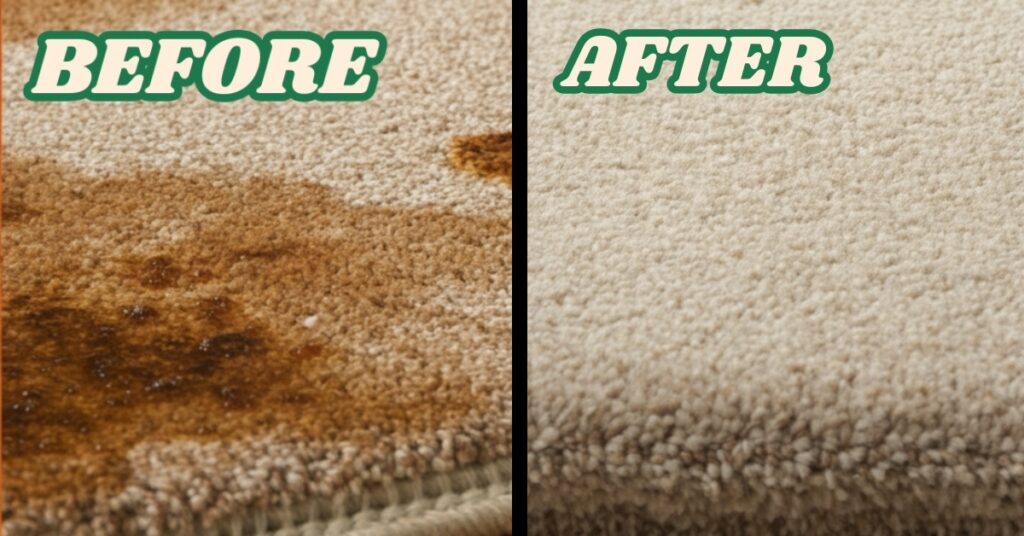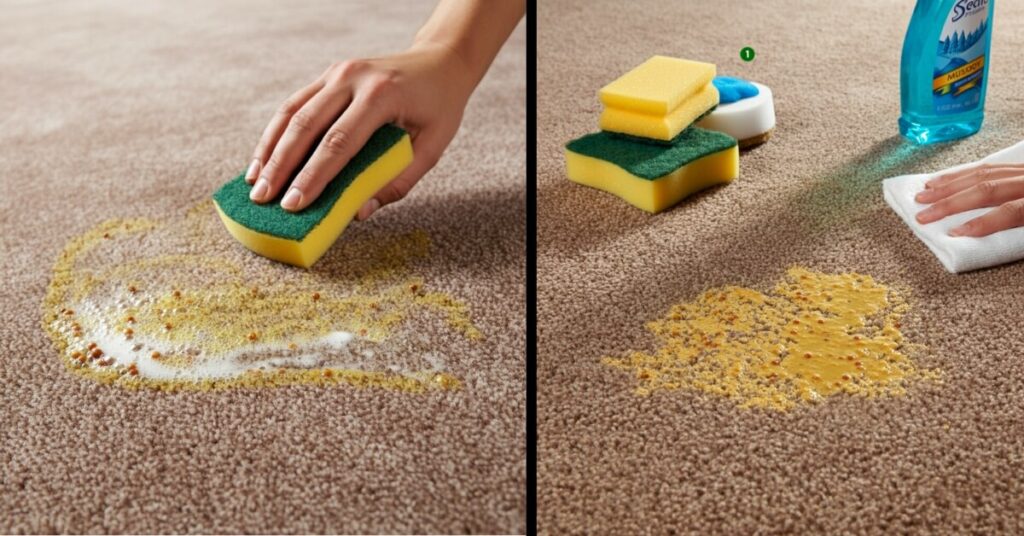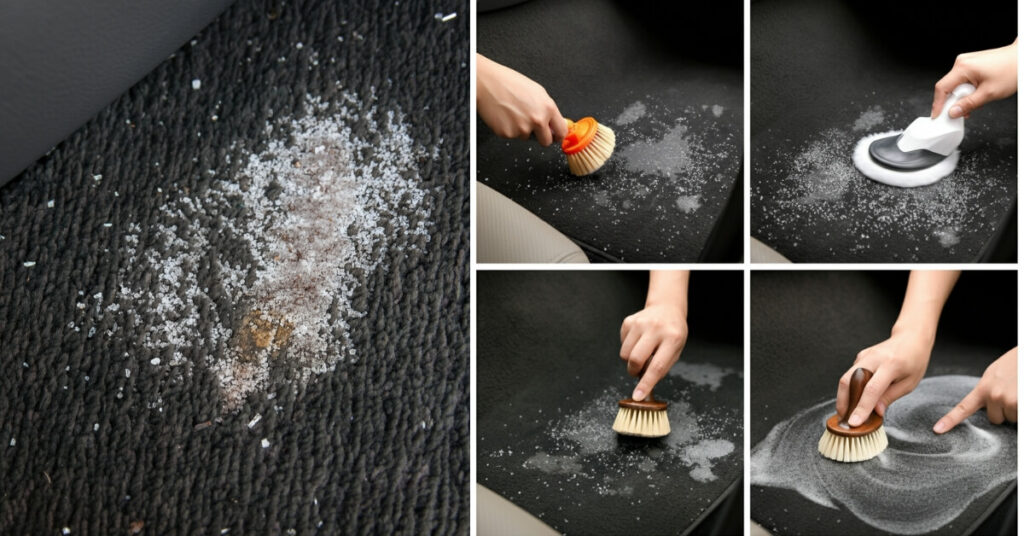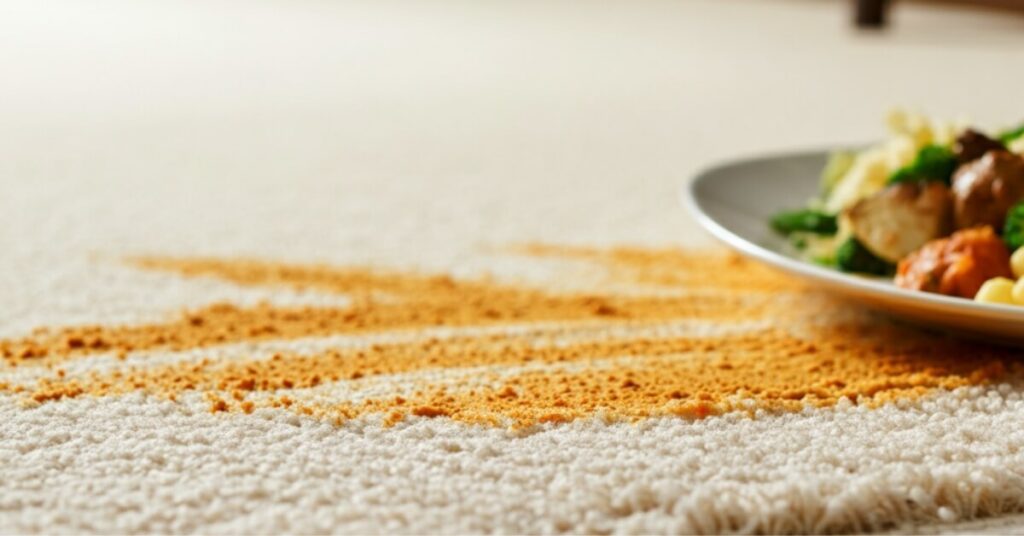As an Amazon Associate, I earn from qualifying purchases.
Ink stains on carpets are never a happy surprise. Whether a pen bursts in your home office, a school project dribbles, or a pen mark happens while you’re jotting something down on the floor, those dark marks can feel like a mini disaster. Even the prettiest carpet can look bad when it has a big blot of ink on it. The good news is that you can usually salvage it if you act quickly and use the right techniques. We will discuss how to get ink stains out if carpet simply.
Ink stains can be stubborn, but they’re not unbeatable. In this guide, I’ll show you safe and simple ways to lift ink out of carpet fibers for good. You’ll learn why ink is so hard to remove, the step-by-step methods you can do at home, and when it’s smart to let a pro take over. By the end, you’ll be ready to rescue your carpet and keep it looking fresh.
Contents Overview
Why Ink Stains Are Tough to Get Out of Carpet
- Ink stains have a reputation for sticking around, and the reason is in how the ink is made. Whether it’s ballpoint pen ink, a permanent marker, or printer ink, the formula typically includes pigments or dyes combined with solvents.
- These ingredients are designed to dry quickly and bond well to paper, which is ideal for writing but a nightmare for carpets.
- Carpet fibers soak up liquids, especially natural ones like wool and cotton, but even synthetic fibers are not immune. When ink spills, the liquid carrier drives the color down and sideways into the carpet’s layers.
- The pigments bond to the fibers and, in some cases, change the color on a molecular level.
- Complicating matters, different carpet types react to cleaning agents in very different ways. Wool and silk are fragile and can be ruined by strong cleaners, while nylon and polyester can take harsher treatments but may still fade or change color.
- The carpet’s style—looped, plush, or cut pile—can also make it easier or harder to lift the stain out completely.
- Another thing to keep in mind is moisture. If your carpet has a thick, heavy pad beneath it, the liquid ink can become trapped there and be difficult to clean. On the other hand, an older carpet with worn-out fibers can absorb the ink and allow it to spread.
- That’s why it’s so important to respond quickly, choose gentle cleaners, and always try any product in a hidden corner first. When you understand these details, you can select the most effective method and increase your chances of removing the stain for good.
How to Get Ink Stain Out of Carpet (Step-by-Step Guide)
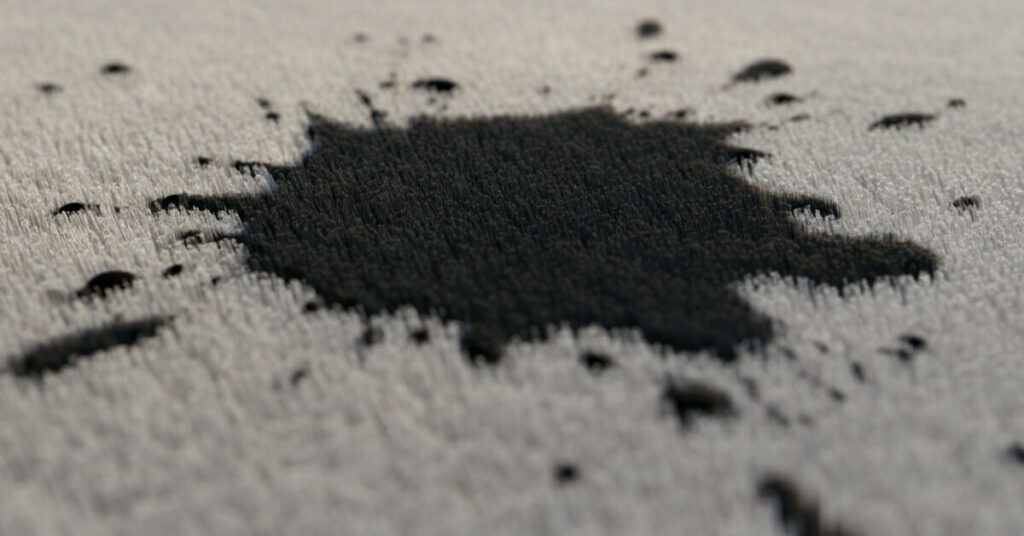
Ink stains can be intimidating, but you can win the battle if you break it down into manageable steps and stay calm.
Step 1: Act Fast
The clock is ticking with ink stains. Each minute the ink sits, it sinks deeper into the carpet, and the cleanup grows tougher. The moment you see a drop—even a tiny one—stop what you’re doing and jump into action to keep it from setting. If the stain is big, take a deep breath and keep a steady hand. Moving purposely and carefully is the best way to save your carpet.
Step 2: Blot the Stain
- Blotting is the most important step to lift as much ink as you can before it has a chance to spread. Grab a clean white towel or a bunch of plain paper towels. Lay the towel on the stain and press down lightly.
- Don’t scrub, rub, or grab a brush right now, because that will push the ink further into the carpet.
- If the stain is big, swap the towel as soon as it soaks through so you don’t push the ink back into the carpet.
- Always start at the edge of the stain and move toward the middle—this prevents the ink from spreading out and making a larger mark. If the stain is new and still wet, blotting alone may lift most, if not all, of the ink.
Step 3: Test Your Cleaner
Before you begin cleaning, you’ll want to protect your carpet, especially if it’s made of natural fibers or features a light or bold color. Find a spot that’s not often seen, like under a couch or behind a chair, and put a tiny drop of your cleaner there.
Leave it for about 5 to 10 minutes, then check for fading, lightning, or damaged fibers. If you encounter any of these issues, consider switching to a different cleaner. Taking this tiny extra step saves you from having a bright spot in the middle of your living room.
Step 4: Apply the Cleaning Solution
Choose your cleaner based on the type of ink stain you’re facing: use rubbing alcohol for ballpoint or most pen stains, a mixture of vinegar and dish soap for general ink, or plain dish soap for light stains. Grab a clean cotton ball or cloth and moisten it with the solution, but don’t soak it.
Gently dab the cotton ball on the ink stain and let the cleaner sit for one to two minutes to loosen the ink. Be patient and let the solution work; don’t pour on extra liquid. Soaking the carpet can push moisture into the backing, which might lead to mildew.
Step 5: Blot Again and Rinse
Grab a clean, damp cloth—just water, no soap. Use it to blot away any leftover cleaner and any more ink that’s come loose. Stick to a clean towel for every blot, just like before. Keep going until the towel comes away clear. Rinse the cloth often so you don’t end up pushing ink back into the carpet. If you’re still seeing ink, go back to the cleaner, then rinse and blot again.
Step 6: Dry the Area
Leftover wetness can make smells or even mold, especially in the carpet padding. To get the spot totally dry, stack dry paper towels or a clean cloth on the wet area. If you can, put a heavy book or object on top to help soak it up. Give it 10 to 15 minutes. When you lift the towels, feel for wet spots and replace with dry ones if needed. For quicker drying, aim a fan at the area or open a window to let air in. For the next step, check out our guide on how to dry carpet after cleaning.
Step 7: Inspect and Repeat if Needed
Once the area has dried, take a moment to look at it from different angles and under various lighting. Run your fingers lightly over the spot to feel for any slippery residue. A slight shadow or tint still showing means you should repeat the blot and rinse procedure. Most stains fade best when treated multiple times with gentle pressure, not one heavy-handed scrub. Keeping a calm, steady hand and a patient attitude usually keeps the fibers safer and the stain fading.
Pro tip: If you’re dealing with a carpet that has bright prints or more than one color, test your cleaning solution first to see if it bleeds or dulls the surrounding dyes.
Best DIY Solutions for Ink Stain Removal
Ink stains pop up from gel, ballpoint, and felt-tip pens, and while many store-bought cleaners do the trick, you can often save time and money with items already in your cupboard. Below are three homemade remedies that keep working and guidelines for each.
1. Rubbing Alcohol. Rubbing alcohol, or isopropyl alcohol, is a solid first choice for oil-based and ballpoint stains. It breaks down the ink without harming most carpet fibers.
How to use it: Lightly moisten a cotton ball or a lint-free cloth with rubbing alcohol. The material should feel damp, not dripping. Lightly press it on the stain and dab outward, lifting the ink a little at a time. If the ball or cloth gets dirty, switch to a clean one and keep going. Keep dabbing the stain with fresh cotton balls until you stop seeing ink on them. When you’re done with the cotton balls, finish up by blotting the area with a cloth soaked in plain water. This gets rid of any leftover alcohol.
Pro Tip: Never pour rubbing alcohol straight onto the carpet. Use a cloth or cotton ball to apply it so you can control how much gets on the carpet. This protects the carpet backing and any glue.
2. Vinegar and Dish Soap
White vinegar is a cleaning superstar. When you mix it with a bit of dish soap, you get a gentle yet powerful stain remover.
How to use it:
- Combine one tablespoon of white vinegar, one teaspoon of dish soap, and 2 cups of warm water.
- Put the mix in a spray bottle and lightly mist it on the ink stain, or dampen a cloth with the solution and apply it by hand.
- Gently blot the stain—don’t rub—so you don’t spread it. Vinegar takes a bit of time to dissolve the ink, so hang in there.
- Once the stain fades, rinse the spot with plain water and blot it dry.
This method is great for water-based ink and some tougher stains. It’s also safe for delicate carpets.
3. Dish Soap Can Handle Light Marks
For a fresh ink drop that’s small and not too dark, a simple pH-neutral dish soap might do the trick.
What to do:
- Stir a little soap—a teaspoon or so—into a cup of warm water.
- Use a white cloth, dip it in the soapy water, and blot the spot gently. Keep repeating until the stain lightens.
- Rinse the area with plain water to wash away any soap.
Tip: To be stain-ready, stash a bottle rubbing the alcohol and a bottle of eco-friendly white vinegar in your cabinet. They ship fast, so you can tackle spills the minute they happen.
When to Call the Professionals
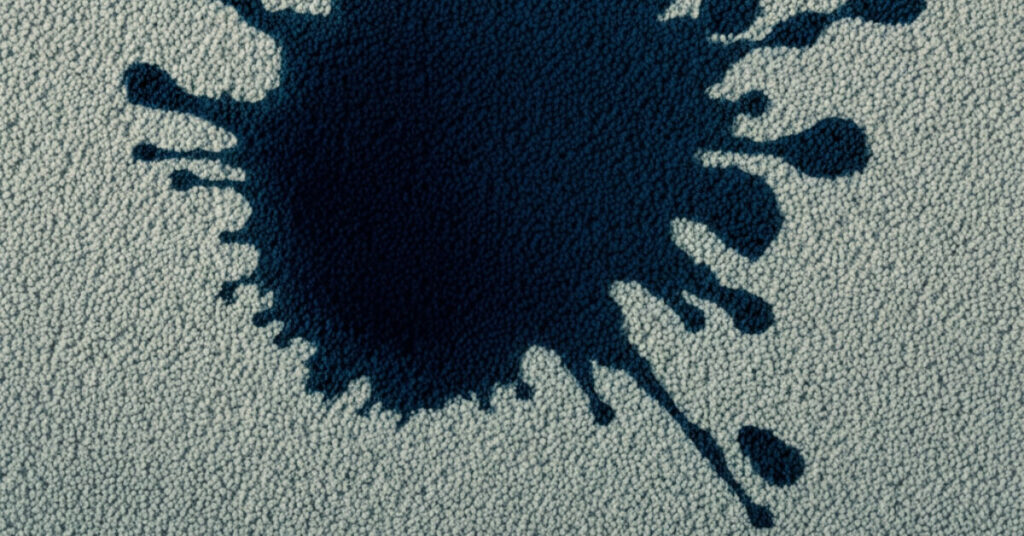
Most ink spills can be handled at home, but some are best left to a professional. Check for these signs:
- The stain has dried and sat for a few days—ink can sink deeper than you can see.
- The mark is large or the carpet is soaked-wet, like a printer cartridge that tipped over. The ink can spread beyond the visible area.
- Expensive, delicate, or antique carpets (like hand-knotted wool): Professional cleaners use specially engineered products and techniques that keep your carpet safe from damage while still getting it clean.
- When repeated DIY attempts haven’t worked: Give yourself limits. After two or three tries with no change, it’s time to call a pro.
- Professional carpet cleaners may use steam cleaning, hot water extraction, or targeted spot treatments to lift the ink. Their advantage is that they can clean the whole carpet without risking shrinkage, fading, or broken fibers.
- Many companies provide free quotes and satisfaction guarantees, so it’s smart to check for proper certifications and read a few good reviews before you book.
- If you plan a cleaning, ask about eco-friendly or pet-safe options. This way, your home stays safe and healthy for everyone, including your furry family members.
FAQs
Will rubbing alcohol damage my carpet?
Rubbing alcohol is safe for most carpet types if used sparingly. Always test on a hidden area before applying it to a visible spot to confirm it won’t cause fading or damage—especially for wool or richly dyed carpets.
What if the ink stain is already dry?
Dried ink stains are harder to remove but not impossible. Simply follow the guide above, but expect to repeat the steps more than once. You can also let the cleaning solution sit on the stain for a few minutes before blotting to help break up the ink.
Can I use hydrogen peroxide on colored carpets?
Hydrogen peroxide is not recommended on most colored carpets, as it can bleach or fade dyes. Only use it on white or very light carpets and always perform a spot test first.
How do I prevent ink from spreading during cleaning?
Prevent spreading by using the right blotting technique—always working from the outside in—and never over-saturating the stain. Switch towels frequently and use just enough solution for each application.
What’s the fastest way to remove fresh ink from carpet?
Blot immediately to lift as much ink as possible. Then use rubbing alcohol or vinegar solution as described above before the ink dries. Acting quickly provides the best chance for complete removal.
Conclusion
Ink stains can feel alarming the moment you spot them, but don’t worry. With quick action and the right supplies, you can save your carpet. The secret is to move fast, use safe cleaning methods, and stay patient. When you know how ink acts, pick the best homemade solution, and recognize when to call in the pros, your carpet will stay in top shape.
Whether the ink mark is tiny or a tough spot that keeps returning, this guide has walked you through practical steps and smart tricks to fix the problem. Make sure your home stays clean and inviting, no matter what spills or pen mishaps cross your path! With these tested methods for ink stain removal, you’ll feel ready to tackle any accident right away, leaving your carpet looking new and lovely for years to come.
As an Amazon Associate, I earn from qualifying purchases.
